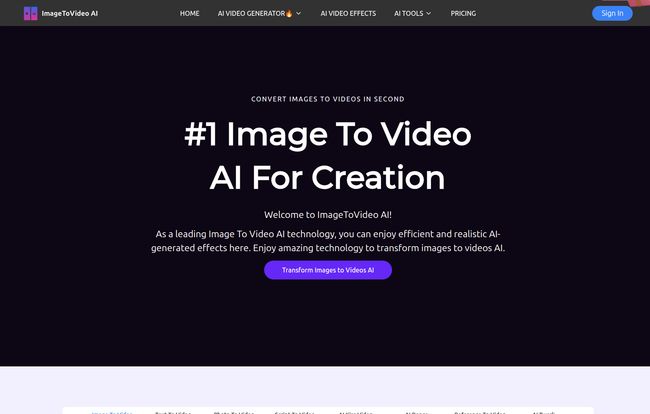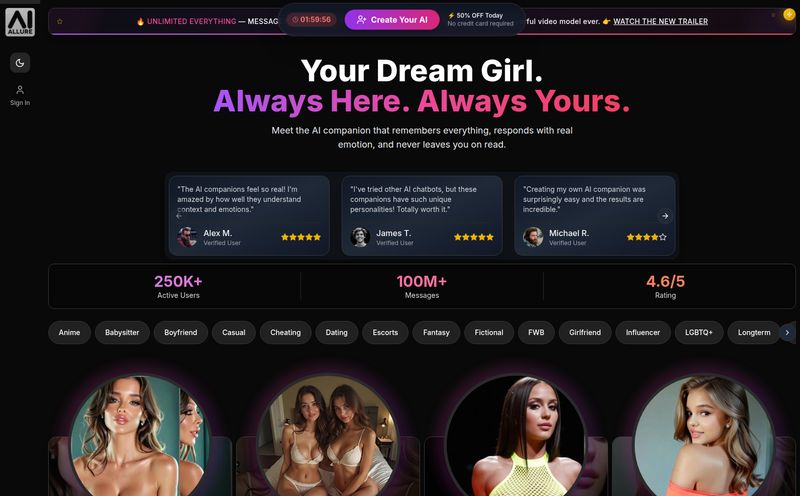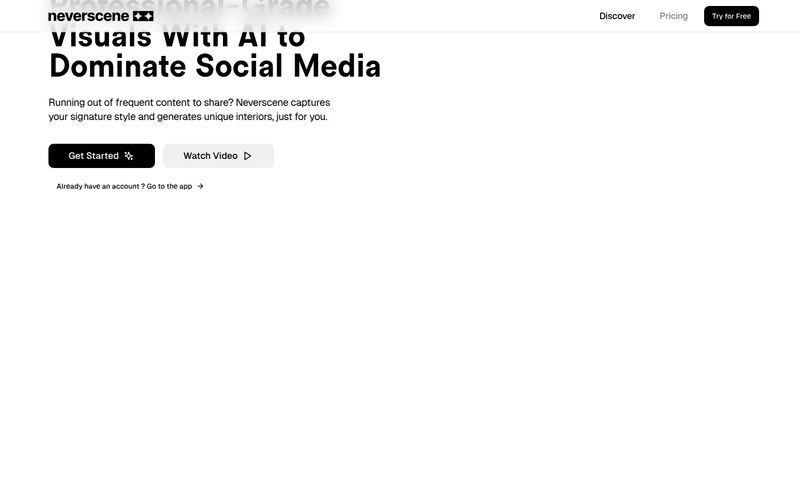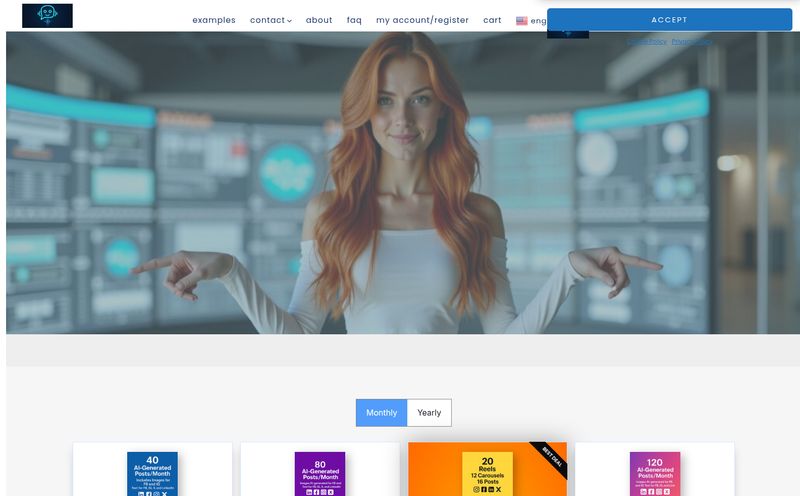As someone who's been swimming in the deep end of SEO, content, and traffic generation for years, I've seen a tidal wave of 'game-changing' AI tools. Every other week, there's a new platform promising to revolutionize how we create content. Most of them are... well, a flash in the pan. They promise the moon and deliver a blurry jpeg of the moon.
So when I stumbled upon ImageToVideo AI, my professional skepticism kicked in immediately. Another tool that turns pictures into videos? Groundbreaking. I was ready to click away, but something about its simplicity made me pause. No complicated promises, just a straightforward pitch: "Free online AI tool to convert images and text into videos."
Alright, you have my attention. I decided to take it for a spin, and frankly, what I found was more interesting than I expected. This isn't just another slideshow maker; it's something a bit different, a bit quirkier, and maybe, just maybe, actually useful for the content-weary marketer.
So, What Exactly Is This Thing?
Think of ImageToVideo AI not as a full-blown video editing suite like Adobe Premiere, but more like a specialized magic wand for your static images. Its main job is to take a single picture (or a text prompt) and animate it using a bunch of different AI models. You’re not stitching clips together; you’re breathing life into one single asset. It's less about filmmaking and more about creating eye-catching, thumb-stopping moments for social feeds.
The whole process is browser-based, which is a huge plus. No downloads, no installations, no begging your IT department for admin rights. You just go to the site, and you're ready to roll.
My First Impressions and Getting Started
The first thing that struck me was the user interface. It’s clean. Deceptively simple, even. In an era where software UIs often look like the cockpit of a space shuttle, this was a breath of fresh air. You're basically looking at three steps laid out right in front of you: Upload an Image, Input Instructions, and Download HD Video.
I grabbed a stock photo, uploaded it (it accepts PNG, JPG, and even WEBP, which is nice), and was presented with a list of effects. There was no head-scratching or hunting for tutorials. It just... worked. For anyone who has ever felt personally victimized by a complicated piece of software, this experience is a relief.

Visit ImageToVideo AI
The Cool Stuff You Can Actually Do
This is where the rubber meets the road. A simple UI is great, but what can it create? The platform is basically a collection of different AI generators, each with its own flavor.
From a Static Photo to a Dynamic Moment
The most basic function is turning a photo into a short video clip. This isn't just a slow, boring zoom like the old Ken Burns effect in iMovie. The AI adds subtle, flowing movements that can make a landscape feel like it's breathing or a portrait's gaze seem to follow you. It's perfect for turning a good photograph into a more engaging background for an Instagram Story or a Facebook ad.
The Wild and Wacky AI Effects (The Fun Part)
Okay, here’s where ImageToVideo AI really shows its personality. Tucked inside are some genuinely fun—and slightly bizarre—AI effects. You can make a photo of your friend (or your boss, I won't tell) break into a dance with the AI Dance generator. Or turn a selfie into something out of a Studio Ghibli film. There's even an "AI Muscle" effect that, well, does exactly what you think it does.
Is it silly? Absolutely. But in a world dominated by 10-second TikToks and Reels, silly sells. This is the kind of stuff that has the potential to go viral for being delightfully weird. I can already see the memes.
Turning Your Words into Moving Pictures
The platform also has a "Script to Video" feature. Now, let's manage expectations here. This is not OpenAI's Sora, generating hyper-realistic cinematic scenes from a paragraph. It's much simpler. You give it a short prompt, and it creates a corresponding animated clip. It's more suited for abstract visuals or simple concepts, but it's another tool in the creative arsenal, especially if you have an idea but no source image to start with.
Who Is This Tool Actually For?
After playing around with it, I've got a pretty good idea of who would get the most out of ImageToVideo AI. It's not for everyone, but for certain people, it could be a secret weapon.
- Social Media Managers & Content Creators: This is the prime audience. You need to feed the content beast daily, and this tool lets you quickly repurpose static images into more engaging video content. It’s a fast way to make your feed look more dynamic without a ton of effort.
- Small Businesses on a Budget: Don't have the cash for a video production team? You can use this to create simple, low-cost product animations or promotional videos for social ads. The fact that you can get a watermark-free export is a big deal here.
- Educators and Students: Imagine making a history presentation where a portrait of a historical figure subtly animates. It's a small touch, but it can make educational content far more memorable.
- You, Having Fun: Let's not discount the pure entertainment value. Making a picture of your cat look like it's in an anime or sending a friend a video of them 'dancing' is, in itself, a worthy pursuit.
Let's Talk Money: The Pricing Breakdown
Here's what really caught my eye. ImageToVideo AI doesn't use a subscription model. Hallelujah! I'm so tired of SaaS subscriptions slowly draining my bank account. Instead, it operates on a one-time payment credit system. You buy a pack of credits, and they're yours to keep forever. They don't expire. This is a model I can get behind.
The pricing is pretty transparent. Different actions cost a different number of credits. For example, making a 5-10 second video from an image costs 6 credits, while a simple AI rewrite is only 1 credit.
Here’s a quick look at the credit packs:
| Price | Credits | Cost Per Credit (Approx.) |
|---|---|---|
| $9.90 | 60 | $0.16 |
| $29.90 | 230 | $0.13 |
| $49.90 | 600 | $0.08 |
| $99.99 | 1600 | $0.06 |
The more you buy, the cheaper each credit gets. For a small business or a solo creator, that $50 pack gives you enough credits to create a hundred pieces of basic video content, which is a pretty great return on investment.
The Not-So-Great Stuff (Let's Be Honest)
No tool is perfect, and it’s important to talk about the trade-offs. The biggest one here is control. If you're a professional video editor who obsesses over keyframes, timing, and color grades in After Effects, this tool will probably make you break out in hives. You can't tweak the animation much beyond the initial prompt. You're giving the AI the car keys and just telling it the destination.
The results can also sometimes be... unpredictable. That's part of the charm of AI, but if you need a very specific outcome for a corporate client, you might have to burn through a few credits to get it right. It's a tool of convenience and speed, not of meticulous artistic control.
Final Verdict: Is ImageToVideo AI Worth Your Time?
So, what's teh final word? In my opinion, yes, it's worth it—for the right person. ImageToVideo AI has found a really smart niche. It’s not trying to replace your entire video production workflow. Instead, it’s an amazing supplementary tool. It's like the Canva of AI video snippets: fast, easy, and surprisingly effective.
The lack of a subscription is a massive win, and the unique, meme-worthy effects give it an edge over more generic 'image animator' tools. It's a fantastic way to add some quick, low-cost flair to your social media presence.
It won't win an Oscar for Best Picture, but it might just win you a few hundred thousand views on your next Reel. And in today's digital world, sometimes that's even better.
Frequently Asked Questions
What are credits in ImageToVideo AI?
Credits are the currency of the platform. Instead of a monthly fee, you buy a pack of credits. Each action you perform, like generating a video or using an AI effect, costs a certain number of credits. They are a one-time purchase and they never expire.
Can I get my videos without a watermark?
Yes. When you use the paid credits to generate a video, the output is in high definition and completely free of any watermarks, which is great for professional or business use.
Is ImageToVideo AI safe for my private photos?
The platform states that it prioritizes privacy protection. Since it's an online tool, you are uploading your images to their servers. According to their site, they have security measures in place, but as with any online service, you should always be mindful of the content you upload.
Do I have to sign up for a monthly subscription?
Nope! And this is one of its best features. ImageToVideo AI is built on a one-time payment, credit-based system. You only pay for what you plan to use, with no recurring charges.
What kind of image files can I use?
The platform is quite flexible, supporting the most common image formats you're likely to have, including PNG, JPG, and WEBP.
How long are the videos it generates?
The standard image-to-video generations are designed for short-form content, typically lasting between 5 and 10 seconds. This is ideal for social media platforms like TikTok, Instagram Reels, and Shorts.
Reference and Sources
- ImageToVideo AI Official Website
- ImageToVideo AI Pricing Page
- OpenAI Sora Announcement (for comparison)



